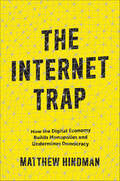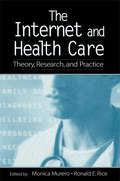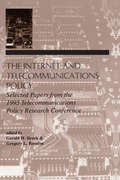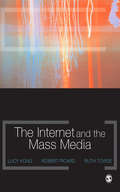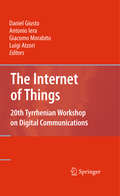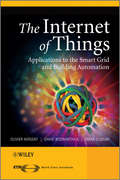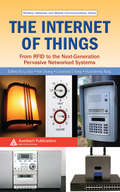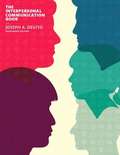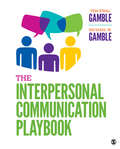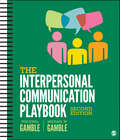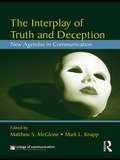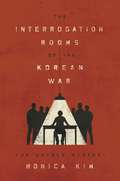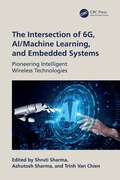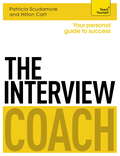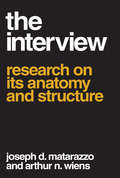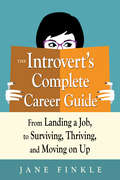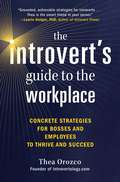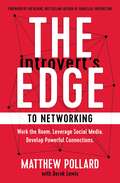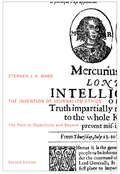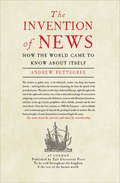- Table View
- List View
The Internet Trap: How the Digital Economy Builds Monopolies and Undermines Democracy
by Matthew HindmanA book that challenges everything you thought you knew about the online economyThe internet was supposed to fragment audiences and make media monopolies impossible. Instead, behemoths like Google and Facebook now dominate the time we spend online—and grab all the profits from the attention economy. The Internet Trap explains how this happened. This provocative and timely book sheds light on the stunning rise of the digital giants and the online struggles of nearly everyone else—and reveals what small players can do to survive in a game that is rigged against them.Matthew Hindman shows how seemingly tiny advantages in attracting users can snowball over time. The internet has not reduced the cost of reaching audiences—it has merely shifted who pays and how. Challenging some of the most enduring myths of digital life, Hindman explains why the internet is not the postindustrial technology that has been sold to the public, how it has become mathematically impossible for grad students in a garage to beat Google, and why net neutrality alone is no guarantee of an open internet. He also explains why the challenges for local digital news outlets and other small players are worse than they appear and demonstrates what it really takes to grow a digital audience and stay alive in today’s online economy.The Internet Trap shows why, even on the internet, there is still no such thing as a free audience.
The Internet and Health Care: Theory, Research, and Practice (Routledge Communication Series)
by Ronald E. Rice Monica MureroThe Internet and Health Care: Theory, Research, and Practice presents an in-depth introduction to the field of health care and the Internet, from international and interdisciplinary perspectives. It combines expertise in the areas of the social sciences, medicine, policy, and systems analysis. With an international collection of contributors, it provides a current examination of key issues and research projects in the area. Methods and data used in the chapters include personal interviews, focus groups, observations, regional and national surveys, online transcript analysis, and much more. Sections in the book cover:*e-Health trends and theory; *searching, discussing, and evaluating online health information at the individual level of analysis; *discussing health information at the group or community level; and *implementing health information systems at the regional and social level. The Internet and Health Care will prove useful for university educators and students in the social, public health, and medical disciplines, including Internet researchers. It is also oriented to professionals in many disciplines who will appreciate an integrative theoretical, empirical, and critical analysis of the subject matter, including developers and providers of online health information.
The Internet and Telecommunications Policy: Selected Papers From the 1995 Telecommunications Policy Research Conference (Lea Telecommunications Ser.)
by Gerald W. Brock, Gregory L. RosstonThis book is based on the Telecommunications Policy Research Conference which reports on research into telecommunications policy issues. While the conference is now a respectable 23 years old, this is only the second printed edition of selected papers. A new law, the Telecommunications Act of 1996, accelerated the process of integration in the communication industry and made major revisions to the Communications Act of 1934 that increase the incentive for integration within the industry. Although the papers in this volume were written prior to the passage of the new law, their importance is merely enhanced by it. They deal with fundamental, complex policy problems that arise when previously separate segments of the telecommunications industry are integrated, rather than specific regulatory rules that are likely to be changed under the new law. With the passage of this law, the timeframe for developing appropriate policies for an integrated industry has been shortened. Changes expected to occur over a period of several years will now likely occur much more rapidly. These papers provide insights to help guide the transition in the industry. Divided into five parts, this volume: * deals with problems of transforming local exchange telephone service from a monopoly in each geographical area to an interconnected competitive network of networks, * considers the pricing problems that arise in an integrated network carrying traffic of different types across multiple service providers, * examines the problem of achieving interoperability in complex networks, * considers issues of intellectual property that arise in expected integrated networks of the future, and * discusses electronic publication of scholarly journals, copyright protection, and the applicability of copyright law in the digital age.
The Internet and the Mass Media
by Ruth Towse Robert G. Picard Lucy Keung"This book analyses issues of the internet and mass media in a rapidly changing environment. It covers a wide range of fundamentals which will be in effect for a longer time, and reflects the benefits of international and interdisciplinary collaboration." - Heinz-Werner Nienstedt, President, European Media Management Education Association "This excellent book will be of great use to researchers, teachers and students interested in the relationship between the Internet and the mass media and it offers an invaluable contribution to the literature. The overall picture that emerges from this book is one that is very balanced, stressing both the radical potential of the internet and the ways in which the various media sectors have experienced the impact differently." - Colin Sparks, University of Westminster What impact has the Internet really had on the media industries? What new regulatory policies and business models are driven by the Internet? And what are the effects of the Internet on how we produce, access and consume music, film, television and other media content? After an initial flurry of analysis and prediction of the future of the dot com boom, this is the first book to review the developments of the first Internet era and investigate its actual outcomes. Bringing together sophisticated analyses from leading scholars in the field, The Internet and the Mass Media explores the far-reaching implications of the Internet from economic, regulatory, strategic and organizational perspectives. This cross-disciplinary, international view is essential for a rich, nuanced understanding of the many technological, economic, and social changes the Internet has brought to the way we live and work.
The Internet of Things
by Luigi Atzori Antonio Iera Giacomo Morabito Daniel GiustoThis book presents a selection of papers submitted to the 20th Tyrrhenian Workshop, which took place in September 2009 in Sardinia, Italy. The workshop focused on the "Internet of Things." This subject is quickly emerging in the wireless technology arena. It describes the pervasive presence of a variety of devices--such as sensors, actuators, and mobile phones--which, through unique addressing schemes, are able to interact and cooperate with each other to reach common goals. This novel paradigm, which originated from the idea of "smart" environments, will be sure to impact the future of logistics, Intelligent Transportation Systems, business and process management, assisted living, E-health, and other applications. The Internet of Things covers a wide array of essential topics related to this emerging paradigm, including infrastructures and applications, communication systems and network architectures, embedded systems, and location and tracking through navigation sensors. It also addresses the technological and social implications of this technology, as well as challenges that may arise.
The Internet of Things
by Olivier Hersent Omar Elloumi David BoswarthickAn all-in-one reference to the major Home Area Networking, Building Automation and AMI protocols, including 802.15.4 over radio or PLC, 6LowPAN/RPL, ZigBee 1.0 and Smart Energy 2.0, Zwave, LON, BACNet, KNX, ModBus, mBus, C.12 and DLMS/COSEM, and the new ETSI M2M system level standard. In-depth coverage of Smart-grid and EV charging use cases.This book describes the Home Area Networking, Building Automation and AMI protocols and their evolution towards open protocols based on IP such as 6LowPAN and ETSI M2M. The authors discuss the approach taken by service providers to interconnect the protocols and solve the challenge of massive scalability of machine-to-machine communication for mission-critical applications, based on the next generation machine-to-machine ETSI M2M architecture. The authors demonstrate, using the example of the smartgrid use case, how the next generation utilities, by interconnecting and activating our physical environment, will be able to deliver more energy (notably for electric vehicles) with less impact on our natural resources.Key Features:Offers a comprehensive overview of major existing M2M and AMI protocols Covers the system aspects of large scale M2M and smart grid applications Focuses on system level architecture, interworking, and nationwide use casesExplores recent emerging technologies: 6LowPAN, ZigBee SE 2.0 and ETSI M2M, and for existing technologies covers recent developments related to interworkingRelates ZigBee to the issue of smartgrid, in the more general context of carrier grade M2M applications Illustrates the benefits of the smartgrid concept based on real examples, including business casesThis book will be a valuable guide for project managers working on smartgrid, M2M, telecommunications and utility projects, system engineers and developers, networking companies, and home automation companies. It will also be of use to senior academic researchers, students, and policy makers and regulators.
The Internet of Things in the Industrial Sector: Security and Device Connectivity, Smart Environments, and Industry 4.0 (Computer Communications and Networks)
by Zaigham MahmoodThis book has a focus on the development and deployment of the Industrial Internet of Things (IIoT) paradigm, discussing frameworks, methodologies, benefits and limitations, as well as providing case studies of employing the IoT vision in the industrial domain. IIoT is becoming an attractive business reality for many organisations such as manufacturing, logistics, oil and gas, energy and other utilities, mining, aviation, and many more. The opportunities for this paradigm are huge, and according to one report, the IIoT market is predicted to reach $125 billion by 2021. The driving philosophy behind the IIoT is that smart machines are better than humans at accurately capturing, analysing and communicating real-time data. The underlying technologies include distributed computing, machine learning, artificial intelligence, and machine-to-machine communication, with a typical IIoT system consisting of intelligent systems (applications, controllers, sensors, and security mechanisms), data communication infrastructure (cloud computing, edge computing, etc.), data analytics (to support business intelligence and corporate decision making), and most importantly the human element. The promised benefits of the IIoT include enhanced safety, better reliability, smart metering, inventory management, equipment tracking, and facilities management. There are, however, numerous issues that are also becoming the focus of active research, such as concerns regarding service availability, data security, and device communication. Lack of ubiquitous interoperability between heterogeneous devices is also a major concern. This book intends to fill a gap in the IIoT literature by providing the scientific contributions and latest developments from researchers and practitioners of international repute, focusing on frameworks, methodologies, benefits, and inherent issues/barriers to connected environments, especially in industrial settings.The intended audience includes network specialists, hardware engineers, and security experts who wish to adopt newer approaches for device connectivity, IoT security, and sensor-based devices design. University level students, researchers and practitioners will also find the latest innovation in technology and newer approaches relevant to the IIoT from a distributed computing perspective.
The Internet of Things: From RFID to the Next-Generation Pervasive Networked Systems (Wireless Networks And Mobile Communications Ser. #12405)
by Laurence T. Yang Yan Zhang Huansheng Ning Lu YanUbiquitous and pervasive technologies such as RFID and smart computing promise a world of networked and interconnected devices. Everything from tires to toothbrushes could soon be in communications range, heralding the dawn of an era in which today's Internet of People gives way to tomorrow's Internet of Things- where billions of obje
The Interpersonal Communication Book, 14th Edition
by Joseph A. DeVito<P>The book approaches the subject of communication through integrative theory, research, and hands-on methods.<P> A threefold approach identifies important communicative concepts: choices in interpersonal situations, the theories and research that support these choices, and the communication skills necessary to effectively use these theories. <P>The text allows readers to examine the question of how, when, and through which channels they should communicate in different contexts.<P> The Fourteenth Edition provides the newest insights and research in person-to-person interaction, making for an up-to-date source for communication study.<P> New features and chapter-by-chapter updates make Interpersonal Communication the most comprehensive, relevant source on the topic.
The Interpersonal Communication Playbook
by Teri Kwal Gamble Michael W. GamblePractical skills for developing successful relationships—both face-to-face and online Written in a conversational style and presented in an innovative handbook format, The Interpersonal Communication Playbook empowers you to take an active role in the development of your communication skills. Best-selling authors Teri Kwal Gamble and Michael Gamble provide you with abundant opportunities to make personal observations, analyze personal experiences, and assess personal growth across interpersonal contexts. Offering an array of communication settings for you to practice your skills, this text makes it easy for you to see how relevant theory can be applied to develop and maintain healthy relationships with family, friends, romantic partners, and coworkers. Key Features Insightful, relatable examples and real-world scenarios engage you and encourage you to critically reflect on your own communication dynamics. “Learning objectives at the beginning of each chapter outline key objectives and help you master important concepts and prepare for exams. Opening vignettes introduce the relevance of chapter content through a contemporary example of communication in action, exemplifying chapter themes with engaging and relevant stories. “What Do You Know?” features promotes self-assessment of knowledge and encourages you to address any misconceptions you discover. “Try This” boxes promote active learning and provide you with opportunities to put your skills into practice. “Reflect On This” boxes connect theory with practice—bringing key concepts and ideas to life. “Analyze This” boxes encourage you to apply critical thinking to examples of interpersonal encounters from literature and popular culture. “Connect the Case” features includes chapter-ending cases designed to help you assess interpersonal communication outcomes to help solidify and further develop the skills learned.
The Interpersonal Communication Playbook
by Teri Kwal Gamble Michael W. GamblePractical skills for developing successful relationships—both face-to-face and online Written in a conversational style and presented in an innovative handbook format, The Interpersonal Communication Playbook empowers you to take an active role in the development of your communication skills. Best-selling authors Teri Kwal Gamble and Michael Gamble provide you with abundant opportunities to make personal observations, analyze personal experiences, and assess personal growth across interpersonal contexts. Offering an array of communication settings for you to practice your skills, this text makes it easy for you to see how relevant theory can be applied to develop and maintain healthy relationships with family, friends, romantic partners, and coworkers. Key Features Insightful, relatable examples and real-world scenarios engage you and encourage you to critically reflect on your own communication dynamics. “Learning objectives at the beginning of each chapter outline key objectives and help you master important concepts and prepare for exams. Opening vignettes introduce the relevance of chapter content through a contemporary example of communication in action, exemplifying chapter themes with engaging and relevant stories. “What Do You Know?” features promotes self-assessment of knowledge and encourages you to address any misconceptions you discover. “Try This” boxes promote active learning and provide you with opportunities to put your skills into practice. “Reflect On This” boxes connect theory with practice—bringing key concepts and ideas to life. “Analyze This” boxes encourage you to apply critical thinking to examples of interpersonal encounters from literature and popular culture. “Connect the Case” features includes chapter-ending cases designed to help you assess interpersonal communication outcomes to help solidify and further develop the skills learned.
The Interpersonal Communication Playbook
by Teri Kwal Gamble Michael W. GambleWritten in a conversational style and presented in an innovative handbook format, The Interpersonal Communication Playbook empowers students to take an active role in the development of their communication skills in both physical and digital arenas. Bestselling authors Teri Kwal Gamble and Michael W. Gamble provide students with ample opportunities to make personal observations, examine personal experiences, and assess their personal growth across interpersonal contexts. The Second Edition features a new chapter on The Cultural Dynamics of Interpersonal Communication in response to the COVID-19 pandemic and lessons learned on adapting communication skills to changing conditions, ways to develop communication resiliency, and the value in practicing mindfulness. This title is accompanied by a complete teaching and learning package. Contact your SAGE representative to request a demo. Learning Platform / Courseware SAGE Vantage is an intuitive learning platform that integrates quality SAGE textbook content with assignable multimedia activities and auto-graded assessments to drive student engagement and ensure accountability. Unparalleled in its ease of use and built for dynamic teaching and learning, Vantage offers customizable LMS integration and best-in-class support. It’s a learning platform you, and your students, will actually love. Learn more. Assignable Video with Assessment Assignable video (available in SAGE Vantage) is tied to learning objectives and curated exclusively for this text to bring concepts to life. Watch a sample video now. LMS Cartridge: Import this title’s instructor resources into your school’s learning management system (LMS) and save time. Don’t use an LMS? You can still access all of the same online resources for this title via the password-protected Instructor Resource Site. Learn more.
The Interpersonal Communication Playbook
by Teri Kwal Gamble Michael W. GambleWritten in a conversational style and presented in an innovative handbook format, The Interpersonal Communication Playbook empowers students to take an active role in the development of their communication skills in both physical and digital arenas. Bestselling authors Teri Kwal Gamble and Michael W. Gamble provide students with ample opportunities to make personal observations, examine personal experiences, and assess their personal growth across interpersonal contexts. The Second Edition features a new chapter on The Cultural Dynamics of Interpersonal Communication in response to the COVID-19 pandemic and lessons learned on adapting communication skills to changing conditions, ways to develop communication resiliency, and the value in practicing mindfulness. This title is accompanied by a complete teaching and learning package. Contact your SAGE representative to request a demo. Learning Platform / Courseware SAGE Vantage is an intuitive learning platform that integrates quality SAGE textbook content with assignable multimedia activities and auto-graded assessments to drive student engagement and ensure accountability. Unparalleled in its ease of use and built for dynamic teaching and learning, Vantage offers customizable LMS integration and best-in-class support. It’s a learning platform you, and your students, will actually love. Learn more. Assignable Video with Assessment Assignable video (available in SAGE Vantage) is tied to learning objectives and curated exclusively for this text to bring concepts to life. Watch a sample video now. LMS Cartridge: Import this title’s instructor resources into your school’s learning management system (LMS) and save time. Don’t use an LMS? You can still access all of the same online resources for this title via the password-protected Instructor Resource Site. Learn more.
The Interplay of Truth and Deception: New Agendas in Theory and Research (New Agendas in Communication Series)
by Mark L. Knapp Matthew S. McGloneDuring the past 30 years, there have been a steadily increasing number of scientific and popular publications dealing with lying and deception. Questions about the extent to which public officials are deceptive are standard fare in current magazines and newspapers. This volume aims to present on a more precise conceptualization of this phenomenon, manifested in some well-known constructions like spin, hype, doublespeak, equivocation, and contextomy (quoting out of context). The contents of the volume have been generated for the New Agendas symposium at the University of Texas College of Communication, and all the authors are young, leading-edge researchers offering innovative perspectives and explorations of lying and deception in various contexts. This volume will appeal to scholars, researchers, and advanced/graduate students in communication, media, and psychology. It is written to the level of advanced undergraduates, and it is appropriate for use in courses covering lying and deception.
The Interrogation Rooms of the Korean War: The Untold History
by Monica KimA groundbreaking look at how the interrogation rooms of the Korean War set the stage for a new kind of battle—not over land but over human subjectsTraditional histories of the Korean War have long focused on violations of the thirty-eighth parallel, the line drawn by American and Soviet officials in 1945 dividing the Korean peninsula. But The Interrogation Rooms of the Korean War presents an entirely new narrative, shifting the perspective from the boundaries of the battlefield to inside the interrogation room. Upending conventional notions of what we think of as geographies of military conflict, Monica Kim demonstrates how the Korean War evolved from a fight over territory to one over human interiority and the individual human subject, forging the template for the US wars of intervention that would predominate during the latter half of the twentieth century and beyond.Kim looks at how, during the armistice negotiations, the United States and their allies proposed a new kind of interrogation room: one in which POWs could exercise their “free will” and choose which country they would go to after the ceasefire. The global controversy that erupted exposed how interrogation rooms had become a flashpoint for the struggles between the ambitions of empire and the demands for decolonization, as the aim of interrogation was to produce subjects who attested to a nation’s right to govern. The complex web of interrogators and prisoners—Japanese-American interrogators, Indian military personnel, Korean POWs and interrogators, and American POWs—that Kim uncovers contradicts the simple story in US popular memory of “brainwashing” during the Korean War.Bringing together a vast range of sources that track two generations of people moving between three continents, The Interrogation Rooms of the Korean War delves into an essential yet overlooked aspect of modern warfare in the twentieth century.
The Intersection of 6G, AI/Machine Learning, and Embedded Systems: Pioneering Intelligent Wireless Technologies
by Ashutosh Sharma Shruti Sharma Trinh Van ChienThis comprehensive guide to the emerging areas and synergistic relationships among the domains of 6G, machine learning, and embedded systems offers readers a detailed analysis of their converging paths and contributions to the development of intelligent wireless systems. Readers will gain a solid understanding of the principles and technologies behind 6G, machine learning, and embedded systems. They will learn how these three areas intertwine and why this intersection is pivotal for the next generation of wireless technologies.The contributors to this volume present a thorough and detailed analysis of this technology, highlighting its promising features, underlying technologies, and potential applications. The book first explores various applications of machine learning algorithms in areas such as network optimization, resource allocation, interference management, and intelligent data processing and analysis. Design considerations and challenges are presented, and case studies of innovative applications, such as smart cities, autonomous vehicles, healthcare, and industrial automation, are examined. The book concludes with a discussion of future trends and opportunities in this rapidly evolving field. Readers will benefit from the theoretical foundations and practical insights presented within and will be prepared to address future challenges and opportunities in these three fields.This book is a valuable resource for academic researchers and industry professionals working in the fields of wireless communication, machine learning, embedded systems, and artificial intelligence.
The Interview Coach: Teach Yourself
by Pat Scudamore Hilton CattBy the end of this book you will be fully prepared to give an outstanding interview .- Identify your strengths and weaknesses- Understand what interviewers are looking for- Practice your answers to typical questions- Build your confidence to tackle any situation- Get the job you wantOther books help you talk the talk. The Teach Yourself Coach books helps you walk the walk.Who are you? * Anyone with an interview coming upWhere this book take you?* You will be fully prepared to give an outstanding interviewHow does it work?* A combination of practical tried-and-tested advice, and unique interactive exercisesWhen can you do it?* In your own time, at your own paceWhat else do you get?* Access to free online videos and printable resourcesWhy Teach Yourself®?* Teach Yourself books are trusted around the world and have helped sixty million people achieve their goals
The Interview: Research on Its Anatomy and Structure
by Arthur N. WiensNearly two decades of research in clinic, industry, and educational settings have enabled the authors to present this compact but comprehensive report on the structure of the interview process. Joseph D. Matarazzo and Arthur N. Wiens have put together a concise presentation of research evidence; free from the dogged adherence to personal opinion that plagues most literature on the subject. The authors present and discuss basic interview concepts: interviewer and interviewee difference in interview behavior, the stability of such behavior, and conditions, which may modify it (including the first solid evidence, independently cross validated by others, for the effect on the interviewee of specific and common interviewer tactics).The book contains a wealth of data on differences in the interview speech behavior of different types of patients, and between persons in different occupations, different administrative hierarchies, and different professional specialties (for example surgical versus psychiatric nurses). Data from the clinical setting also includes evidence for a new and heretofore unsuspected process variable; i.e., a synchrony in the interruption behavior of the therapist and his patient over many psychotherapy sessions.The undergraduate in the communications fields will find this book an excellent adjunct to any of a number of courses in his special curriculum. Graduate students will find a storehouse of leads for theses and dissertations; while the practitioner and teacher in these fields will find much that is new and important to him in each chapter.
The Introvert's Complete Career Guide: From Landing a Job, to Surviving, Thriving, and Moving On Up
by Jane FinkleWhat do Elon Musk, Warren Buffet, Marissa Mayer, and Bill Gates all have in common outside of being wildly successful? They are all introverts. <P><P>In today's fast-paced, unstable workplace achieving success requires speaking up, promoting oneself and one's ideas, and taking initiative. Extroverts, fearless in tooting their own horns, naturally thrive in this environment, but introverts often stumble. If you question your ability to perform and succeed in this extroverted work culture, The Introvert's Complete Career Guide is custom fit for you.In this supportive, all-inclusive handbook, Jane Finkle demonstrates how to use your introverted qualities to their best advantage, then add a sprinkling of extroverted skills to round out a forceful combination for ultimate career success. Finkle shares the keys to navigating each stage of professional development--from self-assessment and job searching, to survival in a new position and career advancement. <P><P>In The Introvert's Complete Career Guide you will learn to:Build confidence by evaluating your values, personality style, interests, and achievements <P><P>Write the story of your career in resume and LinkedIn formats <P><P>Use social media at your own comfort level to promote your career and expand your network <P><P>Express yourself clearly and confidently in network meetings, interviews, and workplace situations <P><P>Build strong professional relationships with colleagues and senior leaders <P><P>Overcome fears that prevent you from embracing new challenges <P><P>Equally applicable to the real or virtual workplace, The Introvert's Complete Career Guide provides strategies, tools, and success stories that win you the professional respect and recognition you deserve.
The Introvert's Guide to the Workplace: Concrete Strategies for Bosses and Employees to Thrive and Succeed
by Thea OrozcoTap Into Your Natural Introvert Strengths in the Office with Actionable Tips and Advice Introverts make up one half of the population, and we&’re hardwired to thrive—especially in the workplace! However, it&’s not uncommon for introverts to feel out of place in the office, where it seems the only ones succeeding are outgoing personalities ready to toot their own horn. Thea Orozco busts that myth, showing how the workplace is truly a setting for introverts to succeed based on their innate skillset and natural introvert strengths. With topics ranging from overcoming phone phobia to developing an authentic leadership style, The Introvert's Guide to the Workplace guides introverts through thriving at work without having to shout—whether you are a boss, an employee, or a career person. Learn from actionable tips and practical advice, and surmount office challenges and let your introversion take the lead: Combat interview anxietyMake meaningful connections at networking eventsBe heard and noticed at meetings or on the stageOvercome imposter syndromeBecome an effective leader with your introvert strengthsAnd more! Including diverse expert interviews, The Introvert's Guide to the Workplace is every working introvert&’s handbook and guide that they can refer to throughout their career for guidance on tricky or draining situations and motivation to enlist the power of their inner introvert to succeed.
The Introverted Presenter
by Richard TierneyThe introvert is a personality type that draws energy from the outside inward. According to standard personality testing assessments, most people are introverts and no group is more introverted than technical professionals. Introverts are congenitally programmed to recoil from the prospect of public speaking with fear and loathing, yet making presentations to expert and non-expert audiences is an inescapable requirement for career advancement in any technical field. Presentation coach Richard Tierney rides to the rescue of fellow introverts in the IT and engineering sectors with The Introverted Presenter--his fail-safe guide to delivering competent presentations, no matter how unsuited by nature you might be to the performing arts. This short book lays out the complete process guaranteed to raise you from a debilitating state of terror and aversion to a comfortable place of clarity, calm, and competence--perhaps even brilliance, if you can train yourself to convert the free energy of your fear into controlled performance. Tierney repeatedly warns his introvert readers that they risk presentation fiasco if they skip, skimp, or change the order of any of the ten steps he prescribes for thoroughly and efficiently preparing their presentations. The surefire sequence of steps for The Introverted Presenter begins with defining your presentation''s audience and objective. The next step is to write the script of your speech in stages, constructing it on the basis of proven structural rules, cognitive laws, and dramatic tricks. Then you incrementally refine and tighten your script by delivering it iteratively, first in front of a mirror and then in front of increasingly critical test audiences, progressing from your cat to your boss. When you have a well-constructed and sound-tested script in hand and only then, you may create some slides to graft into your script in support of your opening action call and your concluding takeaways, which you commit to memory. Your slides should be limited to the smallest number possible (even zero) and the fewest possible words. What you''ll learn By following the process precisely as described in this book, even the most introverted technology professional will gradually but surely acquire the ability to Structure a killer presentation Coach yourself into being the best performer you can be Craft a presentation that supplies your audience''s technical needs while activating its human sympathies Use slides sparingly for best supporting effect Deploy elements of stagecraft like a trouper Who this book is for The primary readership is technology professionals who ordinarily shun the public-speaking limelight but find they need to pitch their work outside their team environments. The secondary readership is non-extroverts in the corporate, commercial, or academic worlds who have taken career promotions that involve presentations as part of their job descriptions. Table of Contents Chapter 1. Introverts and Presentations: Harnessing Terror Chapter 2. Face the Presentation Specter: Feared More Than Death Chapter 3. Find Your Presentation''s Focus: Ready, Steady Chapter 4. Impose Your Presentation''s Structure: Taking the Reins Chapter 5. Write Your Speech: Fear Returns Chapter 6. Refine Your Speech: Relishing the Panic Chapter 7. Try On Your Presenting Persona: Trotting the Course Chapter 8. Master Your Presentation Technology: Bending the Servant to Your Will Chapter 9. Chunk Your Presentation: Linking Primacy, Latency, and Failsafe Devices Chapter 10. Rehearse Your Presentation: Practice, Practice till Thoroughly Bored Chapter 11. Deliver Your Presentation: Treading the Hustings Like a Trouper Chapter 12. Encore! Rolling On to Your Next Presentation Chapter 13. Instant Clarity: Scaring Up an Emergency Presentation in One Day
The Introvert’s Edge to Networking: Work the Room. Leverage Social Media. Develop Powerful Connections (The Introvert’s Edge Series)
by Matthew PollardOne of the biggest myths that plagues the business world today is that our ability to network depends on having the &“gift-of-gab.&” You don&’t have to be outgoing to be successful at networking. You don&’t have to become a relentless self-promoter. In fact, you don&’t have to act like an extrovert at all.The truth is that when introverts are armed with a plan that lets them be their authentic selves, they make the best networkers.Matthew Pollard, an introvert himself, draws on over a decade of research and real-world examples to provide an actionable blueprint for introverted networking. A sequel to Pollard&’s international bestseller The Introvert&’s Edge: How the Quiet and Shy Can Outsell Anyone, this book masterfully confronts the stigma around the so-called extroverted arena of networking.In The Introvert&’s Edge to Networking, you&’ll discover how to:Overcome your fear and discomfort when networkingTurn networking into a repeatable systemLeverage your innate introverted strengthsTarget and connect with top influencersLeverage the power of virtual and social networkingThe introvert&’s roadmap to success doesn&’t look like the extroverts, we&’re different and we should embrace that.Whether you&’re a small business owner struggling to make a living or a professional who&’s hit a career plateau, The Introvert&’s Edge to Networking is your path to a higher income and a rolodex of powerful connections.
The Invention of Journalism Ethics, Second Edition
by Stephen J.A. WardDoes objectivity exist in the news media? In The Invention of Journalism Ethics, Stephen Ward argues that given the current emphasis on interpretation, analysis, and perspective, journalists and the public need a new theory of objectivity. He explores the varied ethical assertions of journalists over the past few centuries, focusing on the changing relationship between journalist and audience. This historical analysis leads to an innovative theory of pragmatic objectivity that enables journalists and the public to recognize and avoid biased and unbalanced reporting. Ward convincingly demonstrates that journalistic objectivity is not a set of absolute standards but the same fallible but reasonable objectivity used for making decisions in other professions and public institutions. Considered a classic in the field since its first publication in 2004, this second edition includes new chapters that bring the book up to speed with journalism ethics in the twenty-first century by focusing on the growing dominance of online journalism and calling for a radical approach to journalism ethics reform. Ward also addresses important developments that have occurred in the last decade, including the emergence of digital journalism ethics and global journalism ethics.
The Invention of Journalism Ethics, Second Edition: The Path to Objectivity and Beyond (McGill-Queen's Studies in the History of Ideas #107)
by Stephen J.A. WardDoes objectivity exist in the news media? In The Invention of Journalism Ethics, Stephen Ward argues that given the current emphasis on interpretation, analysis, and perspective, journalists and the public need a new theory of objectivity. He explores the varied ethical assertions of journalists over the past few centuries, focusing on the changing relationship between journalist and audience. This historical analysis leads to an innovative theory of pragmatic objectivity that enables journalists and the public to recognize and avoid biased and unbalanced reporting. Ward convincingly demonstrates that journalistic objectivity is not a set of absolute standards but the same fallible but reasonable objectivity used for making decisions in other professions and public institutions. Considered a classic in the field since its first publication in 2004, this second edition includes new chapters that bring the book up to speed with journalism ethics in the twenty-first century by focusing on the growing dominance of online journalism and calling for a radical approach to journalism ethics reform. Ward also addresses important developments that have occurred in the last decade, including the emergence of digital journalism ethics and global journalism ethics.
The Invention of News: How the World Came to Know About Itself
by Andrew Pettegree&“A fascinating account of the gathering and dissemination of news from the end of the Middle Ages to the French Revolution&” and the rise of the newspaper (Glenn Altschuler, The Huffington Post). Long before the invention of printing, let alone the daily newspaper, people wanted to stay informed. In the pre-industrial era, news was mostly shared through gossip, sermons, and proclamations. The age of print brought pamphlets, ballads, and the first news-sheets. In this groundbreaking history, renowned historian Andrew Pettegree tracks the evolution of news in ten countries over the course of four centuries, examining the impact of news media on contemporary events and the lives of an ever-more-informed public. The Invention of News sheds light on who controlled the news and who reported it; the use of news as a tool of political protest and religious reform; issues of privacy and titillation; the persistent need for news to be current and for journalists to be trustworthy; and people&’s changing sense of themselves and their communities as they experienced newly opened windows on the world. &“This expansive view of news and how it reached people will be fascinating to readers interested in communication and cultural history.&” —Library Journal (starred review)
